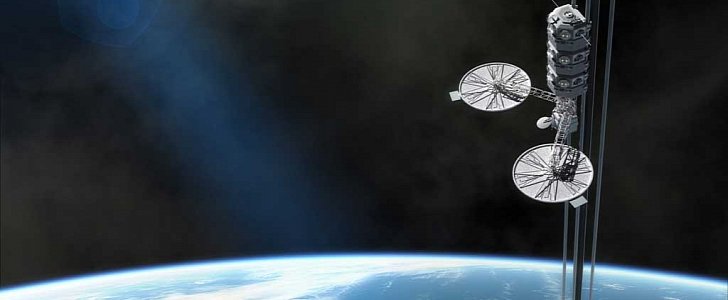Back in the late 1970s, Arthur C. Clarke caused a stir when he brought to the public’s attention the idea of a space elevator: a much easier, cheaper, faster and convenient way to defeat Earth’s gravity and send things and people into space.
His book, Fountains of Paradise, was based on a now over a century old idea by Konstantin Tsiolkovsky: why not use a tether anchored to the surface of the planet at one end and to a space platform at the other to reach space? Why not send pods and down this cable at any time?
Until now, Earth’s mightiest engineers have toyed with this concept in countless ways, but very few have actually tested anything. The idea of a space elevator will finally be put to the test this month, thanks to a team of Japanese researchers from the Shizuoka University in Japan and the astronauts currently on the International Space Station (ISS).
On September 11, the Japanese will be sending to the ISS two ultra-small cubic satellites, a 10-meter-long steel cable and a container.
According to a report by online publication Mainichi, once on the station the two satellites will be deployed and will take their role as the opposite anchors of the steel cable. Along that cable, the container will be moved for the first time and its performances recorded.
The experiment is supported by Obayashi, a corporation that ever since 2014 announced it plans to have a space elevator up and running by the middle of the century.
The Obayashi space elevator concept consists of a 96,000-km long carbon nanotube cable connected to a 400-m diameter floating Earth Port and a 12,500-ton counter-weight.
The deployment of the cable will probably become one of the greatest engineering achievements of all time: a 20-ton cable is deployed initially and is reinforced 510 times by climbers until it reaches a weight of 7,000 tons, ascending in succession over roughly 18 years.
There are, of course, countless challenges to be overcome before such a project becomes feasible, many of which Arthur C. Clarke so vividly detailed in his book.
Until now, Earth’s mightiest engineers have toyed with this concept in countless ways, but very few have actually tested anything. The idea of a space elevator will finally be put to the test this month, thanks to a team of Japanese researchers from the Shizuoka University in Japan and the astronauts currently on the International Space Station (ISS).
On September 11, the Japanese will be sending to the ISS two ultra-small cubic satellites, a 10-meter-long steel cable and a container.
According to a report by online publication Mainichi, once on the station the two satellites will be deployed and will take their role as the opposite anchors of the steel cable. Along that cable, the container will be moved for the first time and its performances recorded.
The experiment is supported by Obayashi, a corporation that ever since 2014 announced it plans to have a space elevator up and running by the middle of the century.
The Obayashi space elevator concept consists of a 96,000-km long carbon nanotube cable connected to a 400-m diameter floating Earth Port and a 12,500-ton counter-weight.
The deployment of the cable will probably become one of the greatest engineering achievements of all time: a 20-ton cable is deployed initially and is reinforced 510 times by climbers until it reaches a weight of 7,000 tons, ascending in succession over roughly 18 years.
There are, of course, countless challenges to be overcome before such a project becomes feasible, many of which Arthur C. Clarke so vividly detailed in his book.

